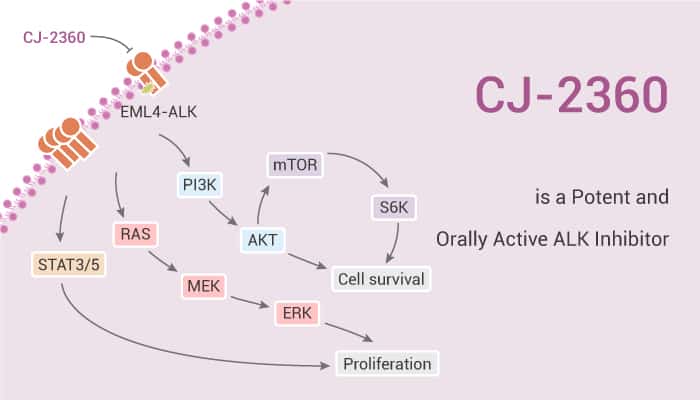Anaplastic lymphoma kinase (ALK) is a receptor tyrosine kinase belonging to the insulin receptor (IR) kinase superfamily. It highly expresses in adult brain tissue and exerts an important role in the development of the nervous system.
Deregulation of ALK originally presents by the identification of at (2;5) chromosomal translocation in anaplastic large cell non-Hodgkin’s lymphoma (ALCL). Following, the fusion of ALK with other genes presents in other cancer, such as large B-cell lymphoma and non-small-cell lung cancer, et al.
In addition to chromosomal translocations leading to fusion proteins. Subsequently, the amplification of the ALK gene and activating point mutations of the wild-type ALK protein also presents in neuroblastoma, breast cancer et al.
In this article, we will introduce a potent and orally active ALK inhibitor, CJ-2360.

As a potent inhibitor, CJ-2360 exhibits IC50s of 2.2, 4.0, 8.8, 6.3, and 8.9 nM against wild-type ALK and F1197M, G1269A, L1196M, and S1206Y ALK mutants, respectively.
In the KARPAS-299 cell line, CJ-2360 achieves an IC50 value of 1.8 nM in inhibition of cell growth. Furthermore, tested-CJ-2360 for its potency in cell growth inhibition in the H3122 cells carrying EML4-ALK. At the same time, it obtains an IC50 value of 3 nM. Additionally, CJ-2360 inhibits Mer tyrosine-protein kinase (MERTK), CLK1, DAPK1, DAPK2, and DAPK3 with IC50s of 6.3, 11, 31, 23, 22, and 260 nM, respectively. CJ-2360 displays >100-fold selectivity for ALK over the insulin receptor kinase (INSR) and show no significant activity against IGF1R.
CJ-2360 at 100 mg/kg is capable of achieving complete in the KARPAS-299 xenograft tumor model. It exhibits long-lasting tumor regression. Additionally, all tumors do not return until day 53, 23 days after the last dose. Besides, CJ-2360 is very effective in the inhibition of ALK phosphorylation. As well as ERK and STAT3 phosphorylation in KARPAS-299 tumor tissue, CJ-2360 plays its effect persisting for at least 24 h.
In conclusion, CJ-2360 potently inhibits wild-type ALK kinase and several ALK mutants. And it is capable to achieve complete tumor regression in the ALK-positive xenograft model with oral administration.
Reference:
Chen J, et al. J Med Chem. 2020;63(22):13994-14016.